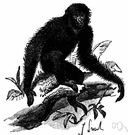siamang
(redirected from siamangs)Also found in: Thesaurus, Encyclopedia.
Related to siamangs: Hylobates syndactylus, Hylobatidae
si·a·mang
(sē′ə-măng′, sē-ăm′əng)n.
A large black gibbon (Hylobates syndactylus syn. Symphalangus syndactylus) of Sumatra and the Malay Peninsula, having an inflatable throat sac and a web of skin joining the second and third toes.
[Malay.]
American Heritage® Dictionary of the English Language, Fifth Edition. Copyright © 2016 by Houghton Mifflin Harcourt Publishing Company. Published by Houghton Mifflin Harcourt Publishing Company. All rights reserved.
siamang
(ˈsaɪəˌmæŋ)n
(Animals) a large black gibbon, Hylobates (or Symphalangus) syndactylus, of Sumatra and the Malay Peninsula, having a large reddish-brown vocal sac beneath the chin and the second and third toes united
[C19: from Malay]
Collins English Dictionary – Complete and Unabridged, 12th Edition 2014 © HarperCollins Publishers 1991, 1994, 1998, 2000, 2003, 2006, 2007, 2009, 2011, 2014
si•a•mang
(ˈsi əˌmæŋ)n.
a large black gibbon, Symphalangus (Hylobates) syndactylus, of Sumatra and the Malay Peninsula.
[1815–25; < Malay]
Random House Kernerman Webster's College Dictionary, © 2010 K Dictionaries Ltd. Copyright 2005, 1997, 1991 by Random House, Inc. All rights reserved.
ThesaurusAntonymsRelated WordsSynonymsLegend:
Switch to new thesaurus
| Noun | 1. |  siamang - large black gibbon of Sumatra having the 2nd and 3rd toes partially united by a web siamang - large black gibbon of Sumatra having the 2nd and 3rd toes partially united by a weblesser ape - gibbons and siamangs genus Hylobates, Hylobates - gibbons |
Based on WordNet 3.0, Farlex clipart collection. © 2003-2012 Princeton University, Farlex Inc.
Translations